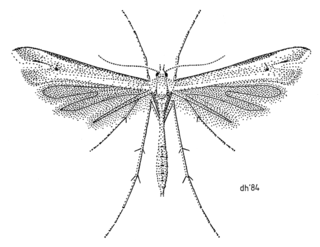
Amblyptilia lithoxesta is a moth of the family Pterophoridae. It is endemic to New Zealand. It was first described by Edward Meyrick in 1885. This species inhabits rough herbage on mountain sides. Larvae feed on Veronica buchananii. Adults are on the wing in January.

Pyroderces aellotricha, also known as the Cosmet moth, is a moth of the family Cosmopterigidae. It is found in New Zealand, in Australia and the Cook Islands.
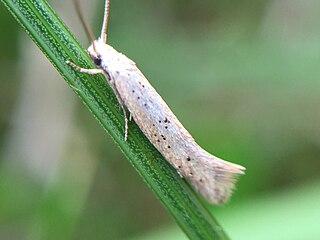
Elachista gerasmia is a species of moth of the family Elachistidae that is found in New Zealand and south eastern Australia.

Rhathamictis perspersa is a moth of the family Psychidae. This species was described by Edward Meyrick in 1924. It is endemic to New Zealand and has been observed in the Wellington region. Larvae of this species build small protective cases in which they hide and feed. The cases are brown and are neat in construction. The larvae live under the loose bark of trees and feed on inert animal matter. The adults have been observed on the wing in February and March.
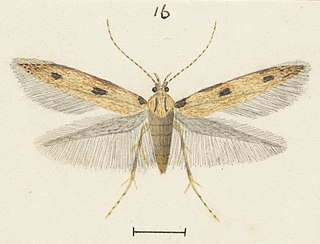
Labdia anarithma is a moth of the family Cosmopterigidae. It was described by Edward Meyrick in 1888. It is found in New Zealand and throughout Australia. Adults are on the wing from December to March and are day flying. They have been collected by sweeping bracken fern.

Eurythecta phaeoxyla is a species of moth of the family Tortricidae. It was described by Edward Meyrick in 1938. It is endemic to New Zealand and has been observed in the Canterbury and Otago regions. The preferred habitat of this species is alpine swampy areas. The larvae feed on herbs and adults are on the wing in February.

Elachista archaeonoma is a species of moth in the family Elachistidae. It was first described by Edward Meyrick in 1889. It is endemic to New Zealand.

Elachista helonoma is a species of moth in the family Elachistidae. This species is endemic to New Zealand. It is classified as "At Risk, Relict'" by the Department of Conservation.
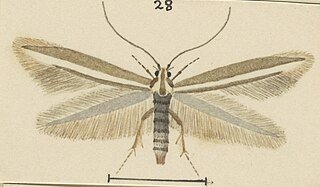
Elachista plagiaula is a moth in the family Elachistidae. It was described by Edward Meyrick in 1938. E. plagiaula is endemic to New Zealand and has been observed in the Mackenzie Basin in the South Island. The preferred habitat of this species is alpine snow-grass. Adults are on the wing in December and are active at dusk.
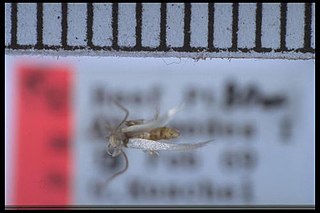
Elachista antipodensis is a moth in the family Elachistidae. It was first described by John S. Dugdale in 1971. It is found on the Antipodes Islands.

Elachista eurychora is a species of moth in the family Elachistidae. This species is endemic to New Zealand and has only been collected at Paekākāriki. The habitat where the adult moth was originally collected was in rough vegetation on coastal sandhills or dunes but the collection locality has been significantly modified since that time. It has been hypothesised that the host of the larvae of this species is a grass. Adults are on the wing in March. It is classified as "Data Deficient" by the Department of Conservation.
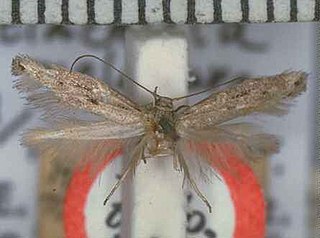
Elachista melanura is a species of moth in the family Elachistidae. This species is endemic to New Zealand. It is classified as "Data Deficient" by the Department of Conservation.

Microcolona limodes is a species of moth in the family Elachistidae. It is endemic to New Zealand. The larvae of this moth eat the seeds of endemic Myrsine species.

Anisoplaca acrodactyla is a species of moth of the family Gelechiidae. It was described by Edward Meyrick in 1907 and is endemic to New Zealand. This species has been observed in South Island as well as in the North Island. Larvae feed on species in the genera Hoheria and Plagianthus including the species Plagianthus regius'.

Kiwaia hippeis is a moth in the family Gelechiidae. This species was first described by Edward Meyrick in 1901. It is endemic to New Zealand and has been collected in Christchurch. Adults of this species are on the wing in December and are attracted to light.

Tingena eriphaea is a species of moth in the family Oecophoridae. It is endemic to New Zealand and has been found in Otago. This species is known to inhabit native beech forest.

Tingena letharga is a species of moth in the family Oecophoridae. It is endemic to New Zealand and has been observed in Otago. Adults are on the wing in December and January.

Tingena melanamma is a species of moth in the family Oecophoridae. It is endemic to New Zealand and has been observed in Marlborough, Otago and Southland.

Atomotricha chloronota is a moth in the family Oecophoridae first described by Edward Meyrick in 1914. It is endemic to New Zealand and is found in the eastern side of the South Island and at the Antipodes Islands. It inhabits clearings with native tussocks and ferns. The larvae feed on leaf litter from silk tunnels in soil. The male adults of this species are on the wing from July to September and have been trapped via sugar traps and are attracted to light. The female of this species is brachypterous.

Holocola charopa is a species of moth in the family Tortricidae. It was first described by Edward Meyrick in 1888. It is endemic to New Zealand and has been observed in the northern parts of the North Island. The larvae web together and feed on the new shoots of their host plant Kunzea ericoides. Adults are on the wing in July and from November until February.




















